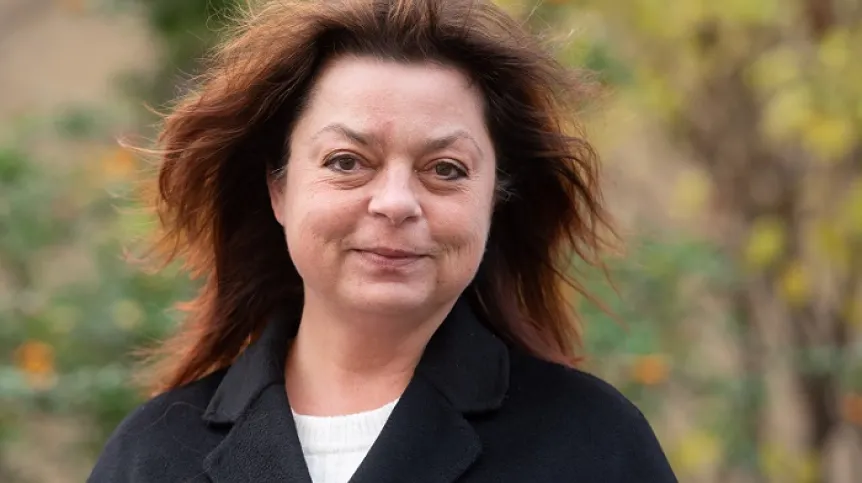
Genes of human endogenous retroviruses (HERVs) present in our genome are generally dormant, inactive and 'silent', but under certain conditions they can be activated, for example as a result of SARS-COV-2 infection, says Professor Agnieszka Szuster-Ciesielska from the Department of Virology and Immunology of the Maria Curie-Sklodowska University in Lublin.
PAP: SARS-COV-2 research results continue to surprises us, new aspects of the virus are being discovering. It was recently found that SARS-COV-2 activates the production of the envelope protein of human endogenous retroviruses (HERVs), dormant in blood lymphocytes and tissues, which affects the inflammation intensity and lung, heart and brain damage. It can complicate the course of COVID-19 even more, but also makes us realise that the mysterious retroviruses in our genome can harm us.
Professor Agnieszka Szuster-Ciesielska: Professor Agnieszka Szuster-Ciesielska: HERV genes combined with the genes of our ancestors a long time ago, 40 million years. They were not eliminated in the course of evolution because it turned out that they were needed.
PAP: What is their important role?
Sz-C.: They have a significant physiological role, as they enable the correct development of the placenta and protect the foetus from rejection by the mother's body.
PAP: In which part of the genome are the retroviral genes, is this the non-coding part representing most of our DNA?
Sz-C.: Yes. Most HERVs are not expressed due to numerous deactivating mutations. These viruses are also often muted by epigenetic mechanisms. Some HERVs, however, are active and their expression is regulated by many different factors, including infectious factors.
PAP: Is the genetic material of retroviruses is always fully dormant?
Sz-C.: HERVs are generally dormant, inactive and 'silent', but under certain conditions they can be activated. The reason for this activation may be X-ray or ultraviolet radiation. This happens in psoriasis. Activation of retroviral genes may also be caused by certain proteins that participate in the development of inflammation, called cytokines. This is one more reason to prevent the development of a long-term inflammation, as with COVID-19 disease.
PAP: Can retroviral genes also be activated during an infection? Latest discovery indicates that SARS-COV-2 viruses can do this.
Sz-C.: Yes, they various types of viral infections can cause this, for example Epstein-Barr infection, herpes, influenza and cytomegalovirus. The activation of retroviral genes causes the production of retrovirus envelope proteins. That is why researchers decided to check if SARS-COV-2 is also capable of activating these genes.
PAP: And they confirmed that it is.
Sz-C.: First, lymphocytes from healthy blood donors were tested was carried out on. It turned out that in one-third of them, these cells produced retrovirus proteins under the influence of SARS-COV-2. Then, COVID-19 patients in various stages of the disease were also tested. In their case, the presence of an endogenous retrovirus envelope protein was also confirmed. Interestingly, its concentration correlated with the intensity of disease symptoms. In patients with severe COVID-19, under intensive care, a much greater concentration of these proteins was detected than in patients with mild or infection.
PAP: What does this mean?
Sz-C.: First of all, the envelope protein of endogenous retrovirus can be a prognostic factor. When its concentration grows, it may suggest the direction of the disease. Research also shows that this protein can be directly involved in the severity of disease symptoms, and responsible for the long-term complications, especially neurological and mental ones. Post-mortem studies of COVID-19 patients showed the presence of this protein in various human organs, for example in the respiratory system and in the brain.
PAP: Could it be possible to predict long COVID in convalescents?
Sz-C.: Researchers are wondering about that, especially that there are also nervous system symptoms in long COVID.
PAP: Can retroviruses in our genome be activated by infections such as SARS-COV-2, ir is it just their envelope proteins?
Sz-C.: No, we are not talking about the entire retroviruses, only their proteins. It is certainly not the case that, for example, the HIV virus other viruses suddenly renew and develop in the body. The whole virus can not form. Endogenous virus proteins have pro-inflammatory and autoimmunization properties. The resulting retrovirus proteins can contribute to the development of certain diseases such as schizophrenia and multiple sclerosis. In patients with multiple sclerosis, retrovirus envelope proteins were detected in the blood.
PAP: Can retroviral genes affect the development of autoimmune diseases?
Sz-C.: They can, scientific reports on this subject have already appeared. Endogenous HERVs can trigger autoimmune diseases such as rheumatoid arthritis or systemic lupus.
PAP: Does SARS-COV-2 have so many properties, or are we simply learning so much about it due to exceptionally intensive research around the world, also in Poland?
Sz-C.: That is true, research on this virus is extremely intensive. There are also more and more observations of long-term consequences of COVID-19. Up to 30 percent persons infected with the coronavirus, after developing COVID-19, be it symptomatic or asymptomatic, mild or severe, experience at least one long-lasting symptom after a few months. This includes various ailments that affect the nervous system, the respiratory system, as well as the cardiovascular system. This will soon become a serious challenge for the entire medical care system for at least a few months.
PAP: We do not know what another wave of COVID-19 will look like, but between waves there are more and more patients that need help due to long COVID.
Sz-C.: There are already recovery centres for these patients, but it may turn out that there are not enough of them. Even now, many people who experience these long-term symptoms struggle with this problem alone and seek help with doctors of various specialties on their own.
Author: Zbigniew Wojtasiński (PAP)
zbw/ zan/ kap/
tr. RL













